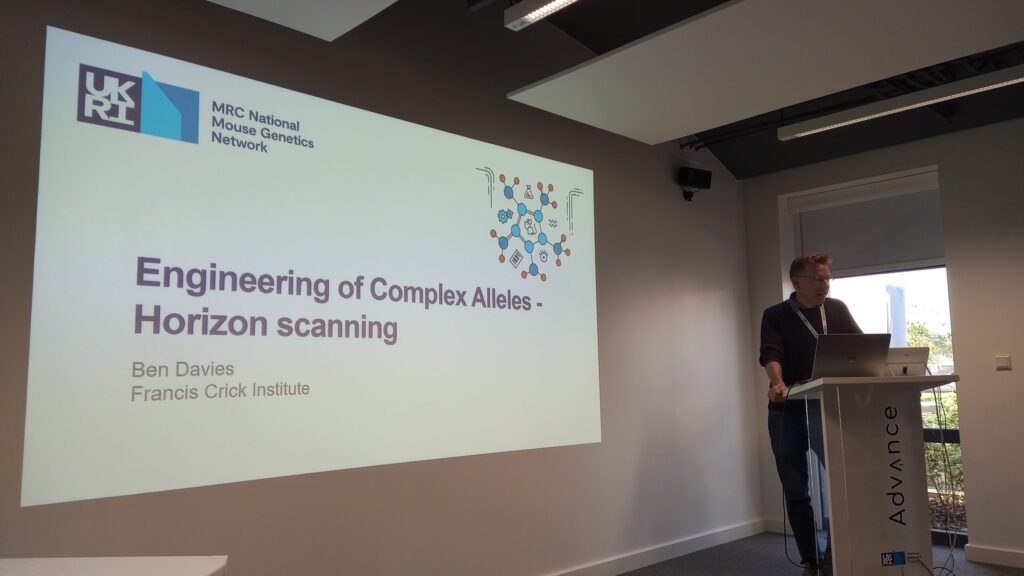Expanding and establishing the Network with growing collaborations, associate membership, and new funding opportunities

Last week we held a Clusters and Associates meeting hosted by the Advance training centre at MRC Harwell, which provided a great opportunity for members and associate members to catch up, network, and discuss future plans and further cross-cluster synergies.
The meeting also provided the platform for our Director, Owen Sansom, to announce the launch of the new MRC National Mouse Genetics Network Director’s Fund. The Fund is an annual award of a total of £200,000 in the first year and £100,000 for the following years of the Network’s lifespan, with individual awards ranging between £20,000 and £100,000 for projects typically running for between 6 and 18 months.
Funded projects need to align with the Network’s ongoing activities and could include technology priming projects that support the whole Network or a specific research cluster, projects that aim to use new models generated by the Network, or projects that make important contributions to the Network. Importantly, the Fund is open for anyone to apply and is currently accepting applications until 27th January 2023.



The Network is already funding some projects outside of the main set of Clusters and we heard from their leads about the work they are planning to do. These projects are of general interest across the Clusters and have the potential to help establish future Clusters and support technology development that will benefit the entire scientific community. The Mouse Pain Network Project, led by John Wood at UCL, focuses on the generation and characterisation of mouse mutant lines that can be used by the scientific community to increase the understanding of pain mechanisms and pathways. Ben Davies, at the Francis Crick Institute, leads the Horizon Scanning Network Project, which is addressing the issue that simple genetically altered mouse models may be of limited use for investigating human disease, by testing, comparing, and optimising technology for large-scale genetic engineering.
Alongside updates about progress made by the Clusters, Data Platform, and recently launched Network-funded projects, we also heard about how Network Associates might engage with the Network. Nick Lench, the Executive Director of the Nucleic Acid Therapy Accelerator (NATA), described what NATA could do to support Network researchers in development of nucleic acid therapies for use in mouse models of disease and Natalie Homer, from the Edinburgh Mass Spectrometry Core explained how they are able to use liquid chromatography tandem mass spectrometry (LC-MS/MS) to dynamically monitor metabolism in mice.






In the last session of the two-day meeting, attendees split up into four breakout groups to discuss the work of our recently created working groups: the Training Working Group, chaired by Haem cluster lead David Kent; the Horizon Scanning Working Group, chaired by Degron Tagging cluster lead Andrew Wood; the Industry & Translation Working Group, chaired by Mitochondria cluster lead Robert Pitceathly; and the Model Systems Working Group, chaired by Mary Lyon Centre at MRC Harwell Director Sara Wells. Each working group focuses on a set of issues relevant across the Network and is tasked with ensuring that developments and opportunities are shared widely, both within and outside of the Network.
The Training Working Group will be focused on identifying training needs across the Network and building a supportive system of training for the next generation of advanced mouse modellers. The Horizon Scanning Working Group will discuss new genetic technologies relevant to the Network and encourage/advise on their early adoption, while also identifying knowledge gaps and potential new collaborators. The Industry & Translation Working Group will set out the Network’s strategy for clinical and industrial collaborations and partnerships, and identify areas of opportunity. The Model Systems Working Group will plan the Network’s strategy for examining projects for replacement opportunities, and will disseminate information about alternative model systems throughout the Network.
If you have ideas for a project that fits with the general aims of the Network in the use of genetically altered mouse models to improve our understanding of human disease, or with the work of a specific research cluster, then apply to the Director’s Fund before 27th January.